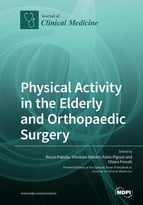Physical Activity in the Elderly and Orthopaedic Surgery
A special issue of Journal of Clinical Medicine (ISSN 2077-0383). This special issue belongs to the section "Orthopedics".
Deadline for manuscript submissions: closed (31 March 2020) | Viewed by 80849
Special Issue Editors
Interests: osteoarthritis; knee surgery; hip surgery; total hip reconstruction; regenerative medicine
Special Issues, Collections and Topics in MDPI journals
Interests: spine surgery; cervical spondylosis; general orthopedics; joint arthroplasty
Special Issues, Collections and Topics in MDPI journals
Interests: sports medicine; physical activity
Special Issue Information
Dear Colleagues,
Old age is increasingly becoming the focus of research and development in Europe. Concerning orthopaedics and sports medicine, the elderly especially are considered as frail patients who need support to maintain the health of their musculoskeletal systems. For this reason, several interventions regarding physical activity have been investigated in recent years, in order to understand whether some programs of physical activity are better than others as conservative treatments for degenerative musculoskeletal pathologies (i.e., osteoarthritis, rotator cuff arthropathy, and lower back pain). Furthermore, several investigations have been carried out to understand the best pre-operative and post-operative protocols of physical activity, to improve the results of orthopaedic surgery. The aim of the present Special Issue is to collect the updated evidence concerning these topics, in the form of a collection of systematic reviews of the literature.
Prof. Dr. Rocco Papalia
Prof. Dr. Vincenzo Denaro
Prof. Dr. Fabio Pigozzi
Dr. Chiara Fossati
Guest Editors
Manuscript Submission Information
Manuscripts should be submitted online at www.mdpi.com by registering and logging in to this website. Once you are registered, click here to go to the submission form. Manuscripts can be submitted until the deadline. All submissions that pass pre-check are peer-reviewed. Accepted papers will be published continuously in the journal (as soon as accepted) and will be listed together on the special issue website. Research articles, review articles as well as short communications are invited. For planned papers, a title and short abstract (about 100 words) can be sent to the Editorial Office for announcement on this website.
Submitted manuscripts should not have been published previously, nor be under consideration for publication elsewhere (except conference proceedings papers). All manuscripts are thoroughly refereed through a single-blind peer-review process. A guide for authors and other relevant information for submission of manuscripts is available on the Instructions for Authors page. Journal of Clinical Medicine is an international peer-reviewed open access semimonthly journal published by MDPI.
Please visit the Instructions for Authors page before submitting a manuscript. The Article Processing Charge (APC) for publication in this open access journal is 2600 CHF (Swiss Francs). Submitted papers should be well formatted and use good English. Authors may use MDPI's English editing service prior to publication or during author revisions.
Keywords
- Elderly
- Physical activity
- Sports medicine
- Orthopaedics
- Osteoarthritis
- Adult joint reconstruction







